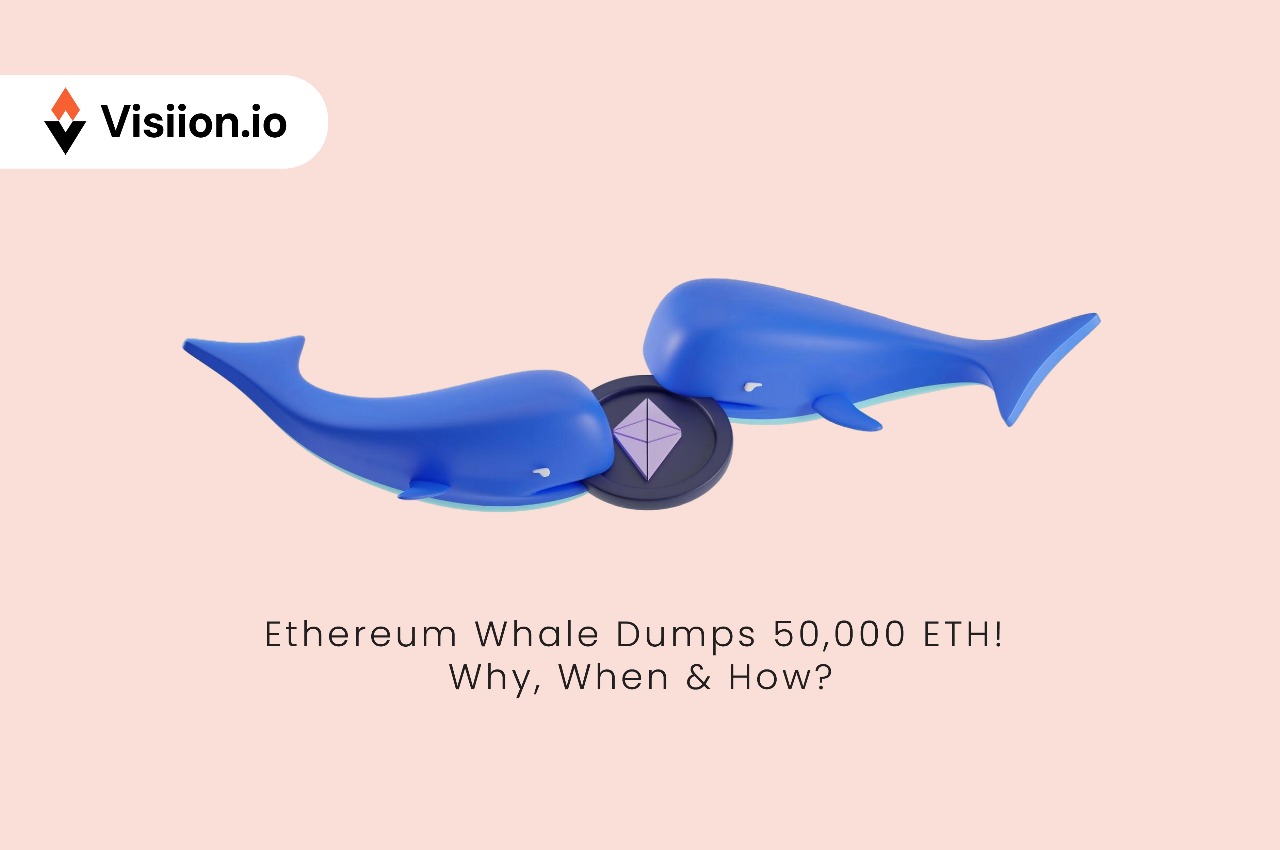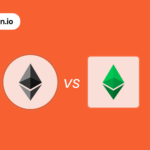Ethereum Whale Dumps 50,000 ETH! Why, When & How?
Ethereum just had a big day, maybe not in terms of an all-time high, but in terms of what happens behind the scenes. An ETH Wahle recently offloaded offload 50,000 ETH and cashed out for nearly $64+ million. What’s more surprising is this happened when the ETH prices were shooting up again. Now, a lot of retail investors and traders might view the rise as a bullish signal and enter. And that’s exactly the difference in how the whales differ from the retailers!
In this blog, we will get deeper into this news and what cues these transactions have for retail investors. So, let’s start.
Ethereum Whales Don’t Think Like the Crowd
Ethereum Whales are battle-tested investors and traders. They’ve weathered bull and bear cycles, survived flash crashes, and probably already made life-changing money. The difference is, they understand that markets are all about timing, emotion, numbers and reading the room.
When a whale moves, they plan every exit and entry. It’s quite the opposite of what a lot of retail traders do. Retails generally make rash and quick decisions purely based on present market conditions. One big candle, let’s sell our stake. One big green candle, let’s take an entry. And that’s exactly why retailers get trapped most of the time.
So it’s obvious that this recent move by a whale was a calculated one. They identified that the market was moving up, and there would be a lot more traders willing to enter. And that’s when they sell their stake. Why one Whale can send a $25 million transaction, and it doesn’t look reckless—it looks calculated. It’s experience and discipline.
What Exactly Happened?
An Ethereum Whale wallet, previously quiet, pushed out 15,000 ETH within a fifteen-minute window yesterday. They swap it all for USDT without any hesitation. That sale happens at an average price of $1,660 per ETH, which is a sweet spot. Then It’s the sweet spot, right as buyers pile in, eager for the next leg up.
What’s surprising is that the market absorbed that order! Imagine the number of buyers available for ETH! ETH closed 10% up! But wait, the game didn’t end there. The very next day, the same Ethereum Whale offloaded an even bigger tranche, another 35,754 ETH!
And again, the market absorbed that. See? That’s the confidence. Imagine the analysis it would have taken to sell at a point where such a massive volume could be absorbed by the market without a single red candle.
Reading Between the Blocks
Now comes the interesting part. What could be the reason behind this massive selloff? Look, Blockchain doesn’t lie. You see every move, every transfer, every play. That’s the beauty of on-chain data. You don’t get hidden deals or off-market trades. You get raw truth.
This Whale’s move tells a simple story. They saw a window—strong price action, plenty of liquidity, and an audience focused on chasing the trend. So, they pulled the trigger. No panic and no scrambling, just pure control.
Traders with the right tools spot the sale, analyze the wallet, and compare it to previous moves. Does this Ethereum Whale always sell after spikes? Are they building a pattern? Sometimes, yes. Sometimes, it’s a one-off. What matters most is the discipline it takes to hit “sell” when everyone else feels greedy.
Why Now? Timing Is Everything
Now, let’s talk about motive. Why did this Ethereum Whale sell here and now? Several reasons make sense—and if you’ve been around, you’ll recognize each one.
First, profit-taking. You can ride a bull market, but every rally ends somewhere. The Whale saw a 4% spike, calculated the gain on 15,000 ETH, and decided the risk of waiting outweighed the chance for a few more points.
Second, rebalancing. If your ETH bag explodes in value, your portfolio gets skewed. Smart money rotates. Some of it gets into stables, some into other coins, some out of crypto entirely. As smart investors know, balance is power.
Third, risk-off signals. Crypto’s volatile. If you think a reversal’s coming, you take money off the table. Big players don’t need to ride every wave to the crest. They surf just long enough, then paddle out and wait for the next set.
Fourth, new opportunities. That $64 million could seed a startup, buy real estate, or fund a different project. Crypto isn’t the only game in town for whales, and they know it.
Finally, tax or liquidity needs. Sometimes, the real world comes calling. It’s possible that a Ethereum Whale might have to deal with some capital obligation or simply want to turn the numbers into something tangible.
How the Market Reacted?
If you were watching ETH price charts, you probably expected fireworks. And fireworks did come, but in the opposite direction! ETH prices shot through the roof. There are numerous reasons behind it. First, Ethereum isn’t a backwater token anymore. Its liquidity runs deep. There are thousands of buyers who are willing to enter if it crosses above their set levels. And hence, the market behaved the way it did.
While its true that such a massive selloff triggered a lot of alarms in the market. Analysts are debating if this is just profit-taking or if big money knows something you don’t. Smaller holders wonder if it’s time to exit or if this is a buy-the-dip opportunity.
So what’s the truth? Well, we believe one Whale can set the mood, but they can’t break the market alone. You saw the dip get bought. That shows strength. It doesn’t guarantee a moonshot, but it might keep the floor solid.
Lessons from the Ethereum Whale Move for Retails?
Well, you are not moving $64 mil, right?! But still, you can learn some lessons here. Here’s what this event teaches every trader and investor.
1. Don’t Get Greedy When Prices Spike.
The Whale didn’t wait for a parabolic blow-off top. They made a solid profit when it was there. The best exits often feel early. Pros know that waiting for “just a little more” leads to missed chances and bigger risks.
2. Use Liquidity As a Tool.
Whales time their moves for peak liquidity. That’s when their size won’t crash the market. Retail can do the same—sell into demand, not panic.
3. Stay Calm When You See Big Moves.
The biggest danger for small traders? Overreacting to an Ethereum Whale action. Make a plan, stick to your risk, and remember that every big sale is not a signal to run for the exits.
4. Read the Blockchain, Not Just the News.
On-chain data gives you the facts. Watch wallet flows, track repeated behaviors, and learn to spot patterns. You’ll start to see through the noise.
5. Diversify Your Moves.
Whales love to diversify. You should do the same. Profits from a good run in ETH can fuel other ideas, support real-life goals, or simply sit in cash and wait for the next opportunity.
Why Ethereum Can Handle the Waves
A few years ago, a $64 million sale would have wrecked ETH price for days. Now, the market shrugs it off. That’s the sign of a maturing asset. Deeper books, smarter traders, and more competition mean even big plays can’t dictate direction like they once did.
If you’re in crypto for the long haul, this matters. You want to see how the market absorbs shocks. Every Ethereum Whale exit tests the ecosystem. This time, Ethereum passed. In fact, the network price shot up. Institutions notice when a market doesn’t crumble at the first sign of stress. Builders keep building. Holders keep holding.
Look Beyond One Sell-Off
Focusing too hard on a single transaction? You’ll miss the story unfolding across the network. This whale move fits into a bigger narrative. It’s a prime example of constant adaptation, shifting strategy, and the never-ending push and pull between big and small players.
You should zoom out. Ask questions: Are more whales selling, or are others quietly buying? Is this just a pit stop on the way to new highs or the start of a larger rotation?
You can track inflows to exchanges, watch for big withdrawals, or even analyze DeFi protocol movements for hints. You might not get a clear answer, but some hints. For sure!
Here’s an approach you, as a smart retail trader, can take:
- Stick to your strategy. If you believe in ETH, think long-term. Don’t let one Whale push you around.
- Use volatility to your advantage if the price dips on big sales, set alerts, and be ready for opportunities.
- Stay informed. Tools like Etherscan, Nansen, and Dune Analytics can help you spot major transactions before they hit the headlines.
- Don’t chase or panic sell. The crowd usually reacts late. Make your own decisions based on what fits your plan.
Whales make the headlines, but it’s the community that makes the market
How Whales Shape the Crypto Cycle?
Whale moves often mark key moments in a cycle. Sometimes, they nail the top or bottom. Sometimes, they might just be managing their risk.
Their decisions send signals. When whales sell after a pump, it’s a sign of maturity. It shows even the biggest holders want to protect capital, not just chase dreams. When they start buying in size after big corrections, the market usually pays attention.
Don’t get caught playing catch-up. Watch for the setups, recognize the signals, and always ask what the smart money sees that you might miss.
What $60 Million Sale Means for Ethereum’s Future?
This transaction is a snapshot of crypto’s evolution. Whales act decisively, but they can’t break the system anymore. At least for blue-chip cryptos like ETH and BTC. Ethereum has grown into an asset class that can handle pressure.
So, if you’re building, holding, or trading in crypto, these moments are your chance to see how the game is really played. The smart money stays smart because it respects both opportunity and risk.
Keep learning from every headline, every block, every surprise move. That’s how you level up and turn Ethereum Whale moves into your edge. And for trading and investing, I always prefer a reliable platform like Visiion.io for better security.










